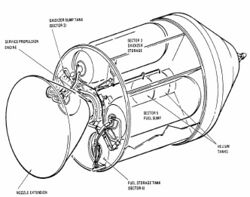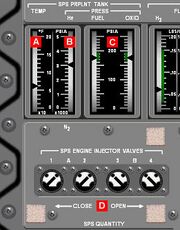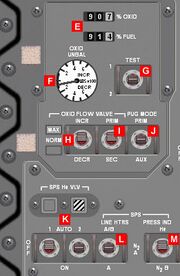Service Propulsion System

The Service Propulsion System (SPS) is the Command/Service Module main engine and provides the impulse for all velocity changes (ΔVs) throughout a mission and the SPS abort capability after the launch escape tower is jettisoned. The engine uses Aerozine 50 (hydrazine/UDMH) fuel and nitrogen tetroxide oxidizer and has a maximum thrust of 20,500 lbf (91.2 kN). This hypergolic fuel combination is pressurized with helium during thrusting periods, so no propellant pump is needed. The propellant flow from the tanks to the thrust chamber is controlled by the engine injector valves, which are pneumatically controlled with nitrogen. The engine is gimbaled to allow thrust vector control during a burn.
Quickstart mode
In Quickstart mode the SPS engine works like a normal Orbiter main thruster. The engine can be throttled with the keyboard or Orbiter's joystick control as usual, although the real SPS engine isn't throttleable. The Interplanetary MFD (IMFD) autoburn program can be used, too. It's not necessary to use the panel displays and controls, the Orbiter engine displays can be used though the panel displays are enabled normally.
Engine thrust on/off logic

In Standard mode and Virtual AGC mode the SPS engine works like the real thing, that means as specified in the original documentationAOH. So the real SPS engine isn't throttleable, it only can be turned on or off by opening or closing one or both of the two pairs of engine injector valves (bipropellant valve systems A or B)3.D pneumatically. The gaseous nitrogen pressure of valve system A and B3.B can be monitored by switching the SPS-PRESS IND switch3.M to N2 A or N2 B.
In order to fire the SPS engine, the ΔV THRUST A and/or ΔV THRUST B switches 1.G are unguarded and switched to NORMAL ("single/double bank operation") to arm the control logic for engine injector valve system A or B.I Now there are 3 ways or thrust modes to fire the engine:
SPS thrust direct on mode
The SPS engine is designed to be very reliable, so the easiest way to fire the engine, just in case everything else failed, is to switch the SPS THRUST switch3.M to DIRECT ON. It can be stopped again by switching back to NORMAL.
CMC ΔV mode
The normal way to control the SPS engine is to use the Command Module Computer. The Virtual AGC uses program P40 to both provide the thrust on signal and to control the SPS thrust vector. The C AGC has a couple of fictional programs to support the different mission phases. For both CMC versions the SC CONT switch1.A is switched to CMC.

SCS ΔV mode
Thrust vector control
In order to control a ΔV manoeuver the SPS engine can be gimbaled and change it's pitch and yaw gimbal angles to provide thrust vector control. Currently only the Virtual AGC does thrust vector control.
The current SPS gimbal angles can be montitored by using the LV TANK PRESS/SPS GIMBAL meter1.C, the -5°/+5° scale is used, provided that the LV/SPS IND switch1.L is in GPI position.
Propellant pressurization
During a burn the fuel and oxidizer in the tanks are pressurized with helium to about 175psi in order to press the propellants through the feet lines to the engine thrust chamber, where they ignite. The helium used for that is stored in the helium tanks, which pressure3.B can be monitored by switching the SPS-PRESS IND switch3.M to He. The fuel and oxidizer tanks are pressurized with the helium pressure regulator assemblies if one if the two SPS helium valves A/B are open. The helium valves are continuous-duty slenoid-operated and are energized open and spring-loaded closed. The SPS He VLV A/B switches3.K permit automatic or manual control of the valvesII. With the switch in the AUTO position, the valves are automatically controlled by the thrust on/off signal, which is the default switch position. The valves are controlled manually by placing the switches to the ON (valve open) or OFF (valve closed) positions. Each valve position is shown by a talk-back indicator3.K above each switch. When a valve is closed, the corresponding indicator is barber-pole(diagonal lines), the indication during non-SPS thrusting periods. When a valve is open, the the corresponding indicator is grey, the indication during SPS thrusting periods.
The helium pressurizing valves can be tested with following procedure:
Propellant utilization

Thermal control
<biblio force=false>
#I The ΔV THRUST A/B switches receive power from the SPS PILOT VLV MNA/B circuit breakers on panel 8 to supply the engine injector valve system A/B. They also receive power from the SPS HE VLV MNA/MNB circuit breakers to power the injector prevalves A/B. Additionally they apply power for the SPS ready signal to the CMC. #II SPS He VLV A/B switches receive power from the SPS HE VLV MNA/MNB circuit breakers on panel 8 to supply the helium valves A/B. #References </biblio>